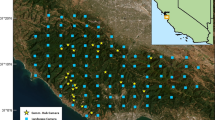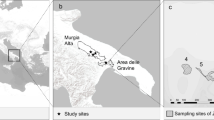Abstract
The carrion fly Chrysomya rufifacies has recently been introduced to North America. Larvae of this species are facultative predators on other carrion larvae, and are known to reduce populations of the New World fly Cochliomyia macellaria in the laboratory and in certain field situations. In order to identify conditions under which native taxa might avoid interaction with the invader, we examined broad patterns of resource use by capturing postfeeding larvae as they left a carcass. The Calliphorinae were least similar to C. rufifacies since they were able to exploit smaller carrion, showed a peak in density during cold weather while C. rufifacies numbers were low, and occurred much earlier than the invader during succession within a carcass. Phormia regina also was most abundant during cold weather. The Sarcophagidae were able to exploit smaller carcasses than the invader but are likely to encounter it in larger carcasses. C. macellaria was the species most similar to C. rufifacies in carrion use, and probably is reduced in number by the invader wherever they coexist. In contrast to all other taxa, C. rufifacies exited a carcass alone, suggesting that other larvae of the same age were attacked. Manipulation of a conspicuous predator, the ant Solenopsis invicta, revealed a negative effect on numbers of P. regina and C. macellaria.
Similar content being viewed by others
References
Baumgartner DL (1986) The hairy maggot blow fly, Chrysomya rufifacies (Macquart) confirmed in Arizona. J Entomol Sci 21:130–132
Baumgartner DL (1988) Spread of introduced Chrysomya blowflies (Diptera: Calliphoridae) in the Neotropics with records new to Venezuela. Biotropica 20:167–168
Baumgartner DL (1993) Review of Chrysomya rufifacies (Diptera: Calliphoridae). J Med Entomol 30:338–352
Baumgartner DL, Greenberg B (1984) The genus Chrysomya (Diptera: Calliphoridae) in the New World. J Med Entomol 21:105–113
Beaver RA (1984) Insect exploitation of ephemeral habitats. S Pac J Nat Sci 6:3–47
Bohart GE, Gressitt JL (1951) Filth-inhabiting flies of Guam. Bull Bernice P Bishop Mus 204:1–169
Colwell RK, Futuyma DJ (1971) On the measurement of niche breadth and overlap. Ecology 52:567–576
Crosby AF (1986) Ecological imperialism. Cambridge University Press, Cambridge
Denno RF, Cothran WR (1975) Niche relationships of a guild of necrophagous flies. Ann Entomol Soc Am 68:741–754
Denno RF, Cothran WR (1976) Competitive interactions and ecological strategies of sarcophagid and calliphorid flies inhabiting rabbit carrion. Ann Entomol Soc Am 69:109–113
Early M, Goff ML (1986) Arthropod succession patterns in exposed carrion on the island of O'ahu, Hawaiian Islands, USA. J Med Entomol 23:520–531
Elton CF (1958) The ecology of invasion by animals and plants. John Wiley, New York
Fuller ME (1934) The insect inhabitants of carrion: a study in animal ecology. Aust Counc Sci Ind Res Bull 82:4–63
Furman DP, Catts EP (1982) Manual of medical entomology. Cambridge University Press, Cambridge
Gagné RJ, Gerrish RR, Richard RD (1982) Correspondence. Entomol Soc Am Newsl 5:9
Greenberg B (1988) Chrysomya megacephala (F.) (Diptera: Calliphoridae) collected in North America and notes on Chrysomya species present in the New World. J Med Entomol 25:199–200
Guimarães J, do Prado A, Linhares AX (1978) Three newly introduced blowfly species in southern Brazil (Diptera, Calliphoridae). Rev Bras Entomol 22:53–60
Guimarães J, do Prado A, Buralli G (1979) Dispersal and distribution of three newly introduced species of Chrysomya Robineau-Desvoidy in Brazil (Diptera: Calliphoridae). Rev Bras Entomol 23:245–255
Hall DG (1948) Blowflies of North America. Thomas Say Foundation, La Fayette
Hanski I (1976) Breeding experiments with carrion flies (Diptera) in natural conditions. Ann Entomol Fenn 42:113–121
Hanski I (1987) Nutritional ecology of dung- and carrion-feeding insects. In: Slansky F, Rodriguez JG (eds) Nutritional ecology of insects, mites, spiders, and related invertebrates. John Wiley, New York, pp 837–884
Hanski I, Kuusela S (1980) The structure of carrion fly communities: differences in breeding seasons. Ann Zool Fenn 17:185–190
Holdaway FG (1930) Field populations and natural control of Lucilia sericata. Nature 126:648–649
Jirón LF (1979) Sobre moscas califoridas de Costa Rica (Diptera: Cyclorrhapha). Brenesia 16:221–222
Kentner E, Streit B (1990) Temporal distribution and habitat preference of congeneric insect species found at rat carrion. Pedobiologia 34:347–359
Kneidel KA (1984) Competition and disturbance in communities of carrion-breeding Diptera. J Anim Ecol 53:849–865
Levot GW, Brown KR, Shipp E (1979) Larval growth of some calliphorid and sarcophagid Diptera. Bull Entomol Res 69:469–475
Liu D, Greenberg B (1989) Immature stages of some flies of forensic importance. Ann Entomol Soc Am 82:80–93
Lodge DM (1993) Biological invasions: lessons for ecology Trends Ecol Evol 8:133–137
MacLeod J, Donnelly J (1957) Some ecological relationships of natural populations of calliphorine flies. J Anim Ecol 26:135–170
Mariluis JC (1981) Nuevos Calliphoridae para la Argentina, Bolivia y Ecuador (Diptera). Rev Soc Entomol Argentina 40:103–105
Mariluis JC, Schnack JA (1989) Ecology of the blow flies of a eusynantropic habitat near Buenos Aires (Diptera, Calliphoridae). Eos Rev Esp Entomol 65:93–101
Meskin I (1986) Factors affecting the coexistence of blowflies (Diptera: Calliphoridae) on the Transvaal Highveld, South Africa. S Afr J Sci 82:244–250
Mönnig HO, Cilliers PA (1944) Sheep blow-fly research VII-Investigations in the Cape winter-rainfall areas. Onderstepoort J Vet Sci Anim Ind 19:71–77
Mooney HA, Drake JA (1989) Biological invasions: a SCOPE program overview. In: Drake JA, Mooney HA, Castri F di, Groves RH, Kruger FJ, Rejmánek M, Willimson M (eds) Biological invasions: a global perspective. John Wiley and Sons, Chichester, pp 491–506
Nicholson AJ (1934) The influence of temperature on the activity of sheep-blowflies. Bull Entomol Res 25:85–99
Norris KR (1959) The ecology of sheep blowflies in Australia. Monogr Biol 8:514–544
Olsen AR, Sidebottom TH (1990) Biological observations on Chrysomya megacephala (Fabr.) (Diptera: Calliphoridae) in Los Angeles, California and the Palau Islands. Pan-Pac Entomol 66:126–130
Paine RT (1974) Intertidal community structure: experimental studies on the relationship between a dominant competitor and its principle predator. Oecologia 15:93–120
Richard RD, Ahrens EH (1983) New distribution record for the recently introduced blow fly Chrysomya rufifacies (Macquart) in North America. Southw Entomol 8:216–218
Salt G (1932) The natural control of the sheep blowfly Lucilia sericata Meigen. Bull Entomol Res 23:235–245
SAS Institute (1985) SAS User's Guide: statistics, version 5 edn. SAS Institute, Cary
Schoenly K, Reid W (1983) Community structure of carrion arthropods in the Chihuahuan desert. J Arid Environ 6:253–263
Schoenly K, Reid W (1987) Dynamics of heterotrophic succession in carrion arthropod assemblages: discrete seres or a continuum of change? Oecologia 73:192–202
Shewell GE (1987) Sarcophagidae. In: McAlpine JF (ed) Manual of nearctic Diptera, vol 2. Research Branch, Agriculture Canada, Ottawa, pp 1159–1186
Simberloff D (1991) Keystone species and community effects of biological introductions. In: Ginzburg LR (ed) Assessing the ecological risks of biotechnology. Butterworth-Heinemann, Boston, pp 1–19
Skidmore P (1985) The biology of the Muscidae of the world. Junk, Dordrecht
Vermeij GJ (1991) When biotas meet: understanding biotic interchange. Science 253:1099–1104
Wells JD (1991) Chrysomya megacephala (Diptera: Calliphoridae) has reached the continental United States: a review of its biology, pest status, and spread around the world. J Med Entomol 28:471–473
Wells JD (1992) Chrysomya rufifacies (Macquart): an introduced blow fly and its effect on the native Cochliomyia macellaria. PhD thesis, University of Illinois at Chicago, Chicago
Wells JD, Breenberg B (1992a) Rates of predation by Chrysomya rufifacies (Macquart) on Cochliomya macellaria (Fabr.) in the laboratory: effect of predator and prey development. Pan-Pac Entomol 68:12–14
Wells JD, Greenberg B (1992b) Interaction between Chrysomya rufifacies and Cochlimyia macellaria (Diptera: Calliphoridae): the possible consequences of an invasion. Bull Entomol Res 82:133–137
Wells JD, Greenberg B (1992c) Laboratory interaction between introduced Chrysomya rufifacies and native Cochliomyia macellaria (Diptera: Calliphoridae). Environ Entomol 21:640–645
Author information
Authors and Affiliations
Rights and permissions
About this article
Cite this article
Wells, J.D., Greenberg, B. Resource use by an introduced and native carrion flies. Oecologia 99, 181–187 (1994). https://doi.org/10.1007/BF00317099
Received:
Accepted:
Issue Date:
DOI: https://doi.org/10.1007/BF00317099




